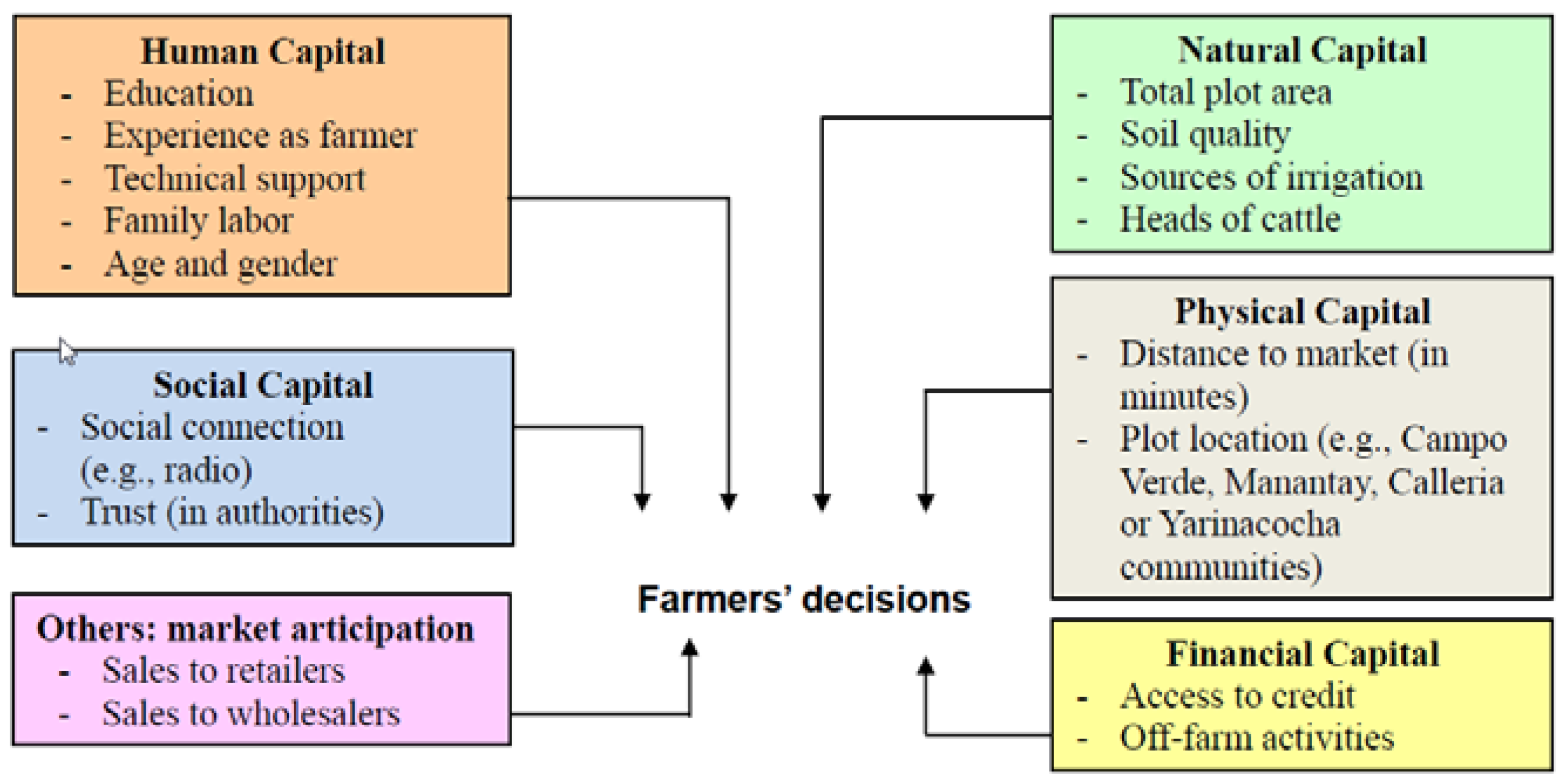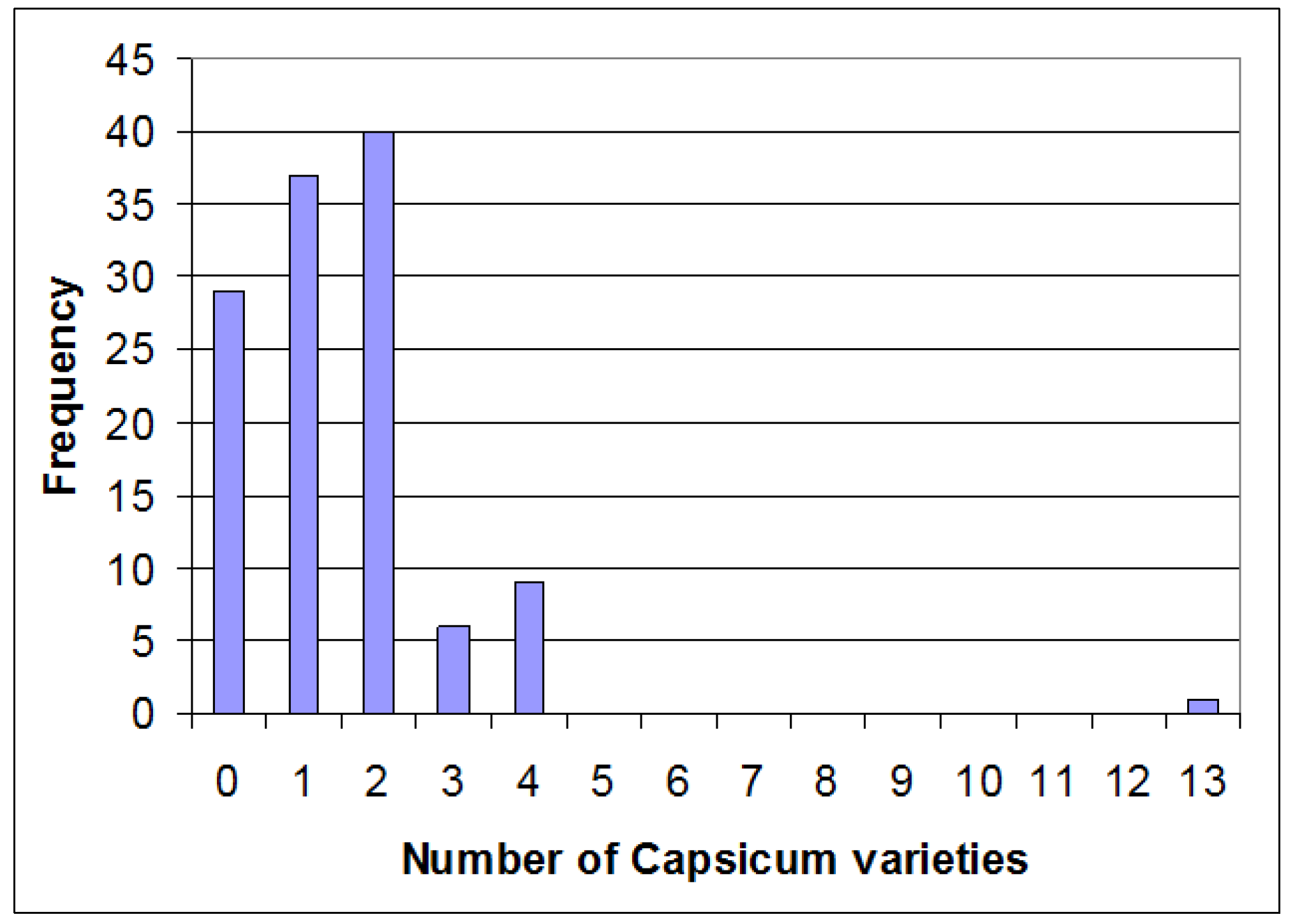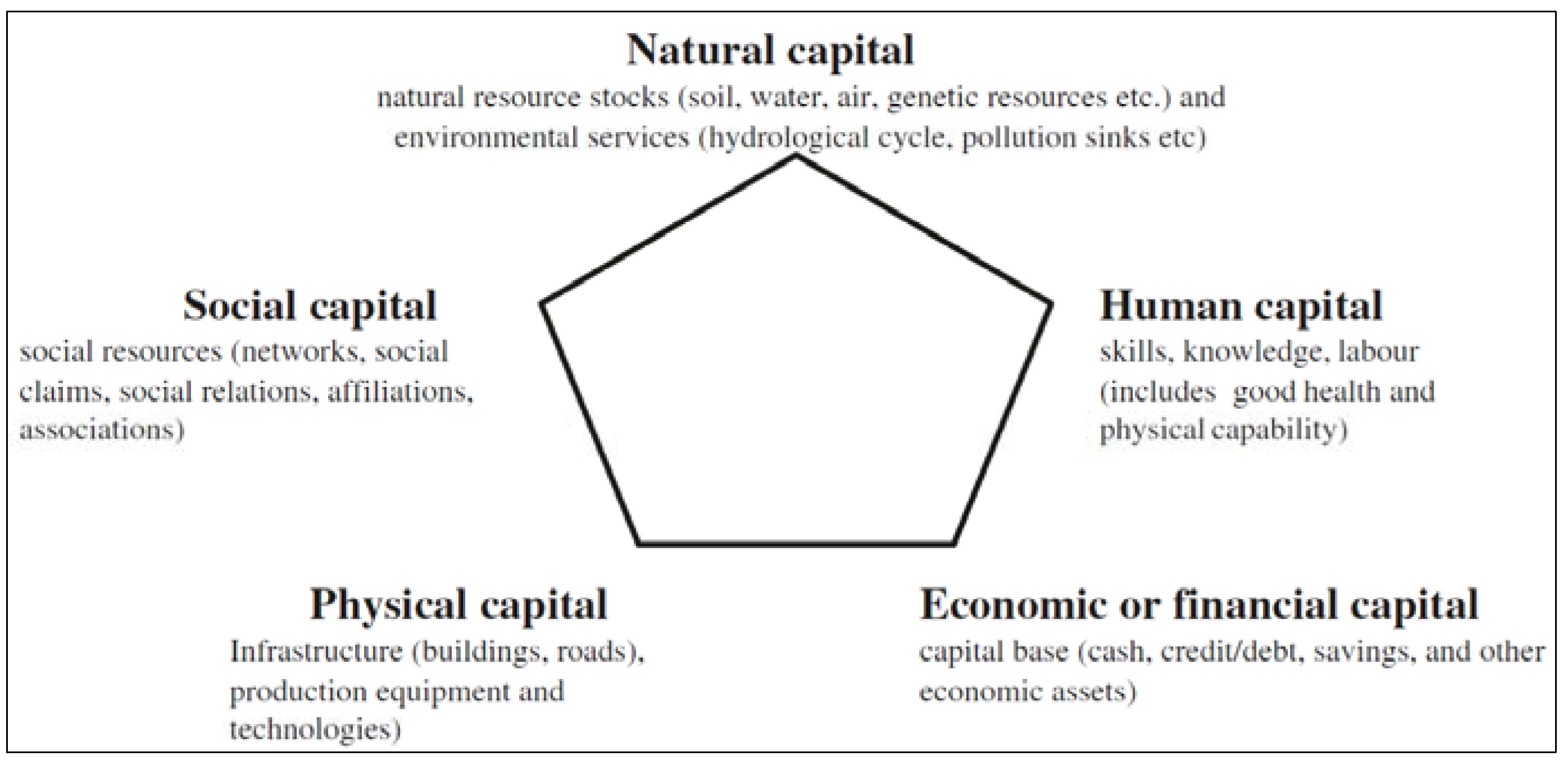Market Participation and Agro-Biodiversity Loss: The Case of Native Chili Varieties in the Amazon Rainforest of Peru
Abstract
:1. Introduction

- Human capital represents “the skills, knowledge, ability to labor and good health that together enable people to pursue different livelihood strategies” [13]. Factors considered in this type of capital include: years of formal education, experience as a farmer, receiving technical support from governmental or non-governmental agencies, the number of members of the family providing farm labor, age and gender (Figure 1). According to [3], formal education and access to technical support could increase the opportunity costs of in situ crop conservation; as such, more educated farmers are expected to preserve a lower number of crop varieties. In addition, age and years of experience [14] as a farmer may be positively associated with crop diversity conservation [15], because older farmers with more experience could have the required knowhow to cultivate a larger number of crop varieties. Family labor has been empirically positively correlated with crop diversity conservation (e.g., [16]), given that cultivating more varieties could be more labor intensive than cultivating less varieties [16]. Female farmers are typically paid lower wages than counterparts. As a result, their opportunity costs of crop diversity conservation are lower [3], and they are expected to preserve a higher number of crop varieties.
- Social capital represents “the social resources upon which people draw in pursuit of their livelihood objectives” [13]. They are developed through networks and connectedness, membership of more formalized groups, relationships of trust, reciprocity and exchanges. Different measures of social capital are expected to affect crop diversity conservation differently, and previous research has indicated mixed results [3]. Variables considered in this type of capital include: a proxy of social connection (radio ownership) and trust in authorities (Figure 1). It is expected that these variables have a positive influence on crop diversity conservation. Similar measures of social capital, e.g., “linking” social capital, statistically significantly increased in situ crop diversity conservation in Ethiopia [17].
- Natural capital represents “the natural resource stocks from which resource flows and services useful for livelihoods are derived” [13]. Factors considered within this type of capital include: total plot area, soil quality, access to a source of irrigation and the number of heads of cattle (Figure 1). Larger total plot area, better soil quality and access to a source of irrigation are expected to have a positive influence on crop diversity, because they facilitate crop production [3]. The number of heads of cattle is expected to have a negative influence on crop diversity, as it could diverge farmer attention to other non-crop related farming activities.
- Physical capital comprises the basic infrastructure (e.g., changes to the physical environment that help people to meet their basic needs and to be more productive) and the producer goods (e.g., tools and equipment that people use to function more productively) needed to support livelihoods [13]. Variables considered in this type of capital include the distance to markets and plot location (Figure 1). Larger distance to markets indicates that farmers face higher transaction costs and, therefore, tend to participate less in the market and have more crop diversity to guarantee self-provisioning [18]. Plot location has an ambiguous effect, based on the infrastructure characteristics and other facilities available in the particular community where the agricultural plot is located. For example, better infrastructure in the community (e.g., roads) would decrease transaction costs, which could decrease the need for self-provisioning and, in turn, decrease in situ crop diversity conservation [18]. On the contrary, the availability of health services in the community could have a positive effect on crop diversity conservation (by increasing labor productivity).
- Financial capital represents the financial resources that people use to achieve their livelihood objectives, including available stocks and regular inflows of money [13]. Factors considered in this type of capital include access to credit and off-farm activities (Figure 1). Access to credit is expected to have a negative effect on crop diversity, because it can favor the ability to purchase more uniform crop seeds. Furthermore, off-farm activities are expected to have a negative effect on crop diversity, because maintaining crop diversity is labor intensive [15].
2. Research Area Description and Survey Conduction
| Community | Number of farmers surveyed |
|---|---|
| Calleria (Mashanga) | 13 |
| Campo Verde (El Pimental and Agua Dulce) | 35 |
| Manantay (Pucallpillo, Ega, Sagrado Corazon, and Jose Olaya) | 46 |
| Yarinacocha (Nueva esperanza de Panaillo) | 34 |
| Total | 128 |
3. Econometric Models and Results
3.1. Econometric Models
3.1.1. Probit Model

3.1.2. (Truncated) Poisson Model


3.1.3. Multinomial Logit Model

3.2. Descriptive Statistics
| Variables | Mean | Standard deviation | Minimum | Maximum |
|---|---|---|---|---|
| Native chili grower (native chili grower = 1, 0 otherwise) | 0.77 | - | 0.0 | 1.0 |
| Number of native chili varieties cultivated by farmers | 1.44 | 1.13 | 0.0 | 4.0 |
| Age (in years) | 46.75 | 13.78 | 22.0 | 75.0 |
| Education (in years) | 7.32 | 3.41 | 0.0 | 16.0 |
| Experience (in years) | 26.87 | 15.55 | 1.0 | 56.0 |
| Gender (male = 1, female = 0) | 0.68 | - | 0.0 | 1.0 |
| Technical support (yes = 1, 0 otherwise) | 0.36 | - | 0.0 | 1.0 |
| Family size (additional number of family members in the household) | 2.49 | 1.48 | 0.0 | 7.0 |
| Total agricultural area (in square meters) | 189,794 | 940,173 | 2,500 | 10,600,000 |
| Opinion about soil quality (from 1 = really bad quality to 5 = really good quality) | 3.56 | 1.16 | 1 | 5 |
| Access to irrigation (yes = 1, 0 otherwise) | 0.24 | - | 0.0 | 1.0 |
| Access to credit (yes = 1, 0 otherwise) | 0.22 | - | 0.0 | 1.0 |
| Performing other economic activities (yes = 1, 0 otherwise) | 0.28 | - | 0.0 | 1.0 |
| Number of head of cattle | 2.55 | 8.03 | 0.0 | 60.0 |
| Trust on local authorities (1 = do not trust, 2 = more or less, 3 = I trust authorities) | 2.46 | 0.76 | 1.0 | 3.0 |
| Radio ownership (yes = 1, 0 otherwise) | 0.71 | - | 0.0 | 1.0 |
| Non market sales (yes = 1, 0 otherwise) | 0.27 | - | 0.0 | 1.0 |
| Market sales to wholesalers (yes = 1, 0 otherwise) | 0.18 | - | 0.0 | 1.0 |
| Market sales to retailers (yes = 1, 0 otherwise) | 0.55 | - | 0.0 | 1.0 |
| Time to market (in minutes) | 64.74 | 49.14 | 2.0 | 300.0 |
| Plot located in rural community of Campo Verde (yes = 1, 0 otherwise) | 0.27 | - | 0.0 | 1.0 |
| Plot located in rural community of Manantay (yes = 1, 0 otherwise) | 0.36 | - | 0.0 | 1.0 |
| Plot located in rural community of Calleria (yes = 1, 0 otherwise) | 0.10 | - | 0.0 | 1.0 |
| Plot located in rural community of Yarinacocha (yes = 1, 0 otherwise) | 0.27 | - | 0.0 | 1.0 |


3.3. Econometric Model Results
| Variables | Probit Model a (Marginal Effects) | Truncated Poisson Model a,b (Marginal Effects) |
|---|---|---|
| Age | 0.00595 ** | 0.00227 |
| (0.00259) | (0.01084) | |
| Education | 0.02681 *** | −0.01437 |
| (0.00872) | (0.01670) | |
| Experience | −0.00173 | −0.00247 |
| (0.00325) | (0.00873) | |
| Male | −0.05184 | 0.11339 |
| (0.07937) | (0.20535) | |
| Technical support | 0.04766 * | 0.34705 * |
| (0.02666) | (0.19886) | |
| Family size | −0.01331 | 0.05633 * |
| (0.02362) | (0.03375) | |
| Total agricultural area | −0.74336 × 10−6 *** | 0.80642 × 10−6 |
| (0.2385 × 10−6) | (0.5251 × 10−6) | |
| Opinion about soil quality | 0.00572 | −0.03373 |
| (0.01628) | (0.06772) | |
| Access to irrigation | 0.24140 *** | −0.01713 |
| (0.01770) | (0.23735) | |
| Access to credit | 0.11331 *** | 0.28767 |
| (0.02207) | (0.21271) | |
| Performing other economic activities | −0.18996 *** | −0.46402 ** |
| (0.03091) | (0.19202) | |
| Number of head of cattle | −0.00284 | −0.00533 |
| (0.00708) | (0.00800) | |
| Trust | −0.02806 | 0.00117 |
| (0.04272) | (0.10720) | |
| Radio | 0.16454 *** | −0.00532 |
| (0.02260) | (0.24582) | |
| Market sales to wholesalers | 0.18798 *** | 0.08270 |
| (0.02155) | (0.47401) | |
| Market sales to retailers | 0.29882 *** | 0.63905 *** |
| (0.03516) | (0.24429) | |
| Time to market | 0.00095 *** | 0.00036 |
| (0.00021) | (0.00158) | |
| Campo Verde | 0.18126 ** | 0.46816 |
| (0.08784) | (0.30016) | |
| Manantay | 0.11500 *** | −0.22991 |
| (0.03558) | (0.31144) | |
| Calleria | −0.00670 | 0.89431 * |
| (0.08864) | (0.48751) | |
| Log likelihood function | −14.93416 | −107.14510 |
| Restricted log likelihood function | −67.97298 | −139.80460 |
| McFadden pseudo R-squared | 0.78029 | 0.23360 |
| Number of observations | 126 | 126 |
| Variables | Multinomial Logit Model a, b, c (Marginal Effects) | ||
|---|---|---|---|
| Non-market participation | Market sales to wholesalers | Market sales to retailers | |
| Age | −0.00175 | 0.00705 * | −0.00530 |
| (−0.21722) | (3.13657) | (−0.47700) | |
| Education | −0.05524 ** | 0.00760 | 0.04764 * |
| (−1.07617) | (0.53109) | (0.67352) | |
| Experience | 0.00121 | −0.00925 ** | 0.00804 |
| (0.08614) | (−2.36613) | (0.41624) | |
| Male | 0.11545 | −0.02188 | −0.09357 |
| (0.20692) | (−0.14064) | (−0.12170) | |
| Technical support | −0.26484 * | 0.03592 | 0.22892 |
| (−0.25129) | (0.12223) | (0.15763) | |
| Family size | −0.06548 | −0.00052 | 0.06600 |
| (−0.43217) | (−0.01221) | (0.31610) | |
| Total area | 0.30925 × 10−6 | −0.53182 × 10−6 ** | 0.22257 × 10−6 |
| (0.15685) | (−0.96744) | (0.08192) | |
| Opinion about soil quality | 0.01967 | 0.03334 | −0.05301 |
| (0.18618) | (1.13225) | (−0.36420) | |
| Access to irrigation | −0.88977 *** | 0.03472 | 0.85506 *** |
| (−0.58161) | (0.08139) | (0.40560) | |
| Access to credit | 0.21353 | −0.03635 | −0.17718 |
| (0.12607) | (−0.07697) | (−0.07591) | |
| Performing other economic activities | 0.17550 | −0.03134 | −0.14416 |
| (0.13322) | (−0.08533) | (−0.07941) | |
| Number of head of cattle | 0.01403 | 0.87383 × 10−4 | −0.01412 |
| (0.09584) | (0.00214) | (−0.06998) | |
| Trust | −0.01513 | −0.03264 | 0.04777 |
| (−0.05871) | (−0.45413) | (0.13449) | |
| Radio | −0.33598 ** | 0.02302 | 0.31296 ** |
| (−0.63760) | (0.15669) | (0.43100) | |
| Time to market | −0.00171 | −0.00074 | 0.00245 |
| (−0.29473) | (−0.45449) | (0.30584) | |
| Campo Verde | −0.37831 * | 0.24566 ** | 0.13265 |
| (−0.27122) | (0.63167) | (0.06901) | |
| Manantay | −0.07268 | 0.08981 | −0.01713 |
| (−0.06896) | (0.30563) | (−0.01180) | |
| Calleria | −0.02347 | 0.31149 ** | −0.28802 |
| (−0.00643) | (0.30624) | (−0.05729) | |
| Log likelihood function | −84.26375 | ||
| Restricted log likelihood function | −129.54640 | ||
| McFadden pseudo R-squared | 0.3495478 | ||
| Number of observations | 126 | ||
4. Discussions and Conclusions
Acknowledgments
Conflicts of Interest
References and Notes
- Bioversity International. Descubriendo el potencial de la diversidad de los cultivos olvidados para la diferenciación de productos de alto valor y la generación de ingresos para los pobres: El caso de los chiles en su centro de origen; Project proposal presented to Deutsche Gesellschaft fuer Internationale Zusammenarbeit (GIZ); GIZ: Cali, Colombia, 2009. (in Spanish) [Google Scholar]
- Eshbaugh, H. History and Exploitation of a Serendipitous New Crop Discovery. In New Crops; Janick, J., Simon, J., Eds.; Wiley: New York, NY, USA, 1993. [Google Scholar]
- Isakson, S. Market provisioning and the conservation of crop biodiversity: An analysis of peasant livelihoods and maize diversity in the Guatemalan highlands. World Dev. 2011, 39, 1444–1559. [Google Scholar] [CrossRef]
- Bosland, P.; Votava, E. Peppers: Vegetables and Spice Capsicums; CABI Publishing: Oxfordshire, UK, 2000. [Google Scholar]
- Bellon, M. Conceptualizing interventions to support on-farm genetic resource conservation. World Dev. 2004, 32, 159–172. [Google Scholar] [CrossRef]
- Lybbert, T.; Barrett, C.; Narjisse, H. Market-based conservation and local benefits: The case of argan oil in Morocco. Ecol. Econ. 2002, 41, 125–144. [Google Scholar] [CrossRef]
- Smale, M. Concepts, Metrics and Plan of the Book. In Valuing Crop Biodiversity: On-Farm Genetic Resources and Economic Change; Smale, M., Ed.; CABI Publishing: Washington, DC, USA, 2006. [Google Scholar]
- Lockie, S.; Carpenter, D. Agriculture, Biodiversity and Markets. In Agriculture, Biodiversity and Markets: Livelihoods and Agroecology in Comparative Perspective; Lockie, S., Carpenter, D., Eds.; Earthscan: London, UK, 2010. [Google Scholar]
- Jackson, L.; Pascual, U.; Hodgkin, T. Utilizing and conserving agrobiodiversity in agricultural landscapes. Agr. Ecosys. Environ. 2007, 121, 196–210. [Google Scholar] [CrossRef]
- Cameron, A.; Trivedi, P. Microeconometrics Using STATA, Revised Edition; Stata Press: College Station, TX, USA, 2010. [Google Scholar]
- Benin, S.; Smale, M.; Pender, J. Explaining the Diversity of Cereal Crops and Varieties Grown on Household Farms in the Highlands of Northern Ethiopia. In Valuing Crop Biodiversity. On-Farm Genetic Resources and Economic Change; Smale, M., Ed.; CABI Publishing: Washington, DC, USA, 2006. [Google Scholar]
- Morse, S.; McNamara, N. The Theory Behind the Sustainable Livelihood Approach. In Sustainable Livelihood Approach: A Critique of Theory and Practice; Morse, S., McNamara, N., Eds.; Springer: New York, NY, USA, 2013. [Google Scholar]
- DFID Sustainable livelihoods guidance sheets. Emergency Nutrition Network: Oxford, UK, 1999. Available online: http://www.ennonline.net/resources/667 (accessed on 13 December 2013).
- Age and experience tend to be correlated (older farmers are usually more experienced). A correlation was not found in the sample. Similar situation was also observed in [15].
- Edmeades, S.; Smale, M.; Karamura, D. Demand for Cultivar Attributes and the Biodiversity of Bananas on Farms in Uganda. In Valuing Crop Biodiversity. On-Farm Genetic Resources and Economic Change; Smale, M., Ed.; CABI Publishing: Washington, DC, USA, 2006. [Google Scholar]
- Van Dusen, E. Missing Markets, Migration and Crop Diversity in the Milpa System of Mexico: A Household-Farm Model. In Valuing Crop Biodiversity. On-farm Genetic Resources and Economic Change; Smale, M., Ed.; CABI Publishing: Washington, DC, USA, 2006. [Google Scholar]
- Winters, P.; Cavatassi, R.; Lipper, L. Sowing the Seeds of Social Relations: The Role of Social Capital in Crop Diversity; ESA Working Paper N 6-16; European Space Agency: Rome, Italy, 2006. [Google Scholar]
- Winters, P.; Hintze, L.; Ortiz, O. Rural Development and the Diversity of Potatoes on Farms in Cajamarca, Peru. In Valuing Crop Biodiversity. On-Farm Genetic Resources and Economic Change; Smale, M., Ed.; CABI Publishing: Washington, DC, USA, 2006. [Google Scholar]
- Greene, W. Econometric Analysis; Prentice Hall: Bergen County, NJ, USA, 2003. [Google Scholar]
- Meckelmann, S.; Riegel, D.; van Zonneveld, M.; Rios, L.; Pena, K.; Ugas, R.; Quinonez, L.; Mueller-Seitz, E.; Petz, M. Compositional characterization of native Peruvian chili peppers (Capsicum spp.). J. Agr. Food Chem. 2013, 61, 2530–2537. [Google Scholar] [CrossRef]
- Instituto Nacional de Estadística e Informática (INEI). Censos nacionales 2007, XI de poblacion and VI de vivienda. Available online: http://censos.inei.gob.pe/cpv2007/tabulados/# (accessed on 13 December 2013).
- Breen, R. Regression Models: Censored, Sample-Selected, or Truncated Data; Sage Publications: Thousand Oaks, CA, USA, 1996. [Google Scholar]
- Greene, W. Limdep Econometric Modeling Guide, Version 10; Econometric Software, Inc.: New York, NY, USA, 2012.
- Abera, G. Commercialization of Smallholder Farming: Determinants and Welfare Outcomes. Master Thesis, University of Agder, Kristiansand, Norway, 2009. [Google Scholar]
- Jaleta, M.; Gebremedhin, B.; Hoeksa, D. Smallholder Commercialization: Processes, Determinants and Impact; Discussion Paper No. 18; International Livestock Research Institute: Addis Ababa, Ethiopia, 2009. [Google Scholar]
- International Federation of Organic Agriculture Movements (IFOAM). Participatory Guarantee Systems; IFOAM: Bonn, Germany, 2007. Available online: http://www.ifoam.org/sites/default/files/page/files/ifoam_pgs_web.pdf (accessed on 13 December 2013).
- Bengtsson, J.; Ahnstrom, J.; Weibull, A. The effects of organic agriculture on biodiversity and abundance: A meta-analysis. J Appl. Ecol. 2005, 42, 261–269. [Google Scholar] [CrossRef]
- Mendoza, G. A Primer on Marketing Channels and Margins. In Prices, Products, and People: Analyzing Agricultural Markets in Developing Countries; Scott, G., Ed.; Lynne Rienner Publishers: Boulder, CO, USA, 1995. [Google Scholar]
© 2014 by the authors; licensee MDPI, Basel, Switzerland. This article is an open access article distributed under the terms and conditions of the Creative Commons Attribution license (http://creativecommons.org/licenses/by/3.0/).
Share and Cite
Garcia-Yi, J. Market Participation and Agro-Biodiversity Loss: The Case of Native Chili Varieties in the Amazon Rainforest of Peru. Sustainability 2014, 6, 615-630. https://doi.org/10.3390/su6020615
Garcia-Yi J. Market Participation and Agro-Biodiversity Loss: The Case of Native Chili Varieties in the Amazon Rainforest of Peru. Sustainability. 2014; 6(2):615-630. https://doi.org/10.3390/su6020615
Chicago/Turabian StyleGarcia-Yi, Jaqueline. 2014. "Market Participation and Agro-Biodiversity Loss: The Case of Native Chili Varieties in the Amazon Rainforest of Peru" Sustainability 6, no. 2: 615-630. https://doi.org/10.3390/su6020615
APA StyleGarcia-Yi, J. (2014). Market Participation and Agro-Biodiversity Loss: The Case of Native Chili Varieties in the Amazon Rainforest of Peru. Sustainability, 6(2), 615-630. https://doi.org/10.3390/su6020615





